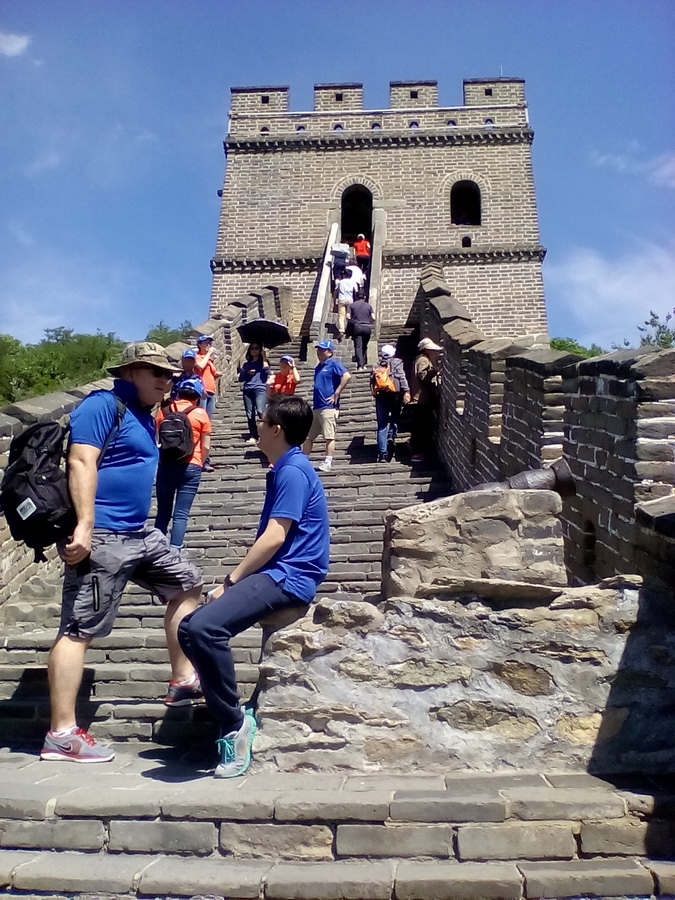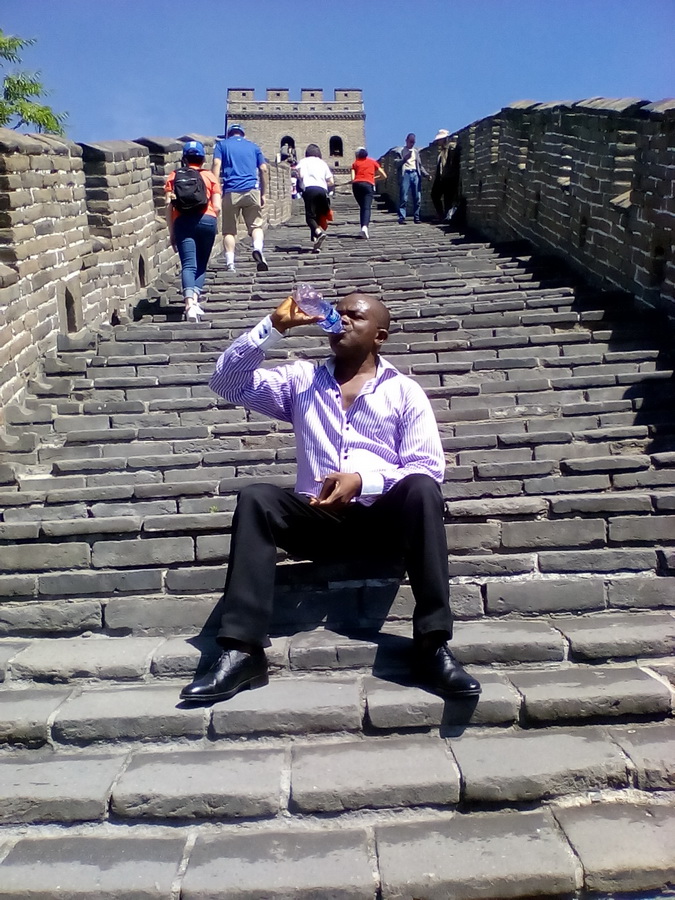


The Great Wall stretches
Hundreds of years ago, the urge and instinct of self preservation and security made China’s leaders, emperors in the past dynasties, to embark on most daring and arduous measures – the building of walls hundreds of kilometers in and around most capitals and major cities.
Because China’s capital city changed many times and because of some other important cities that needed to be secured, security walls, today called Great Wall, were built in so many parts of the vast country.
Indeed the Walls are great and have become the symbol for which the world knows China. They are the most prominent archaeological and historic relics of the country and today also money spinner that attracts millions of people from all over the world every year to see the wonders and climb them.
History of the Walls, as recounted on walls and motifs on some of them is that the earliest were built by the first emperor of China about 250BC while most of the rest were erected during the Ming Dynasty that coincides with the Middle Ages around 1368 to 1640s.
Amazing past and present
Whereas it took great ingenuity and bravery to build those Walls then with just manual effort, it has taken equal courage and sense of identity to revive, renovate and keep them alive and well today by the present governments of China.
On one of them, there are even international cooperation and interventions to keep the relics of history. For instance, at the 15th Watchtower of the Mutianyu Wall, one of the most prominent, there is a milestone indicative that the Henkel Institute of Dusseldorf, Germany in May 1989 facilitated rebuilding the Wall as sign of friendship for the world on the relic that signified security measures in past times.
World attraction
From records, about 11m tourists visit the two most prominent Great Walls at Badalling and Mutianyu every year. Everyday, for the three times I have been at the Great Wall at Badalling, Mutianyu and Miyun, it brims with human beings of all races, ages and sexes. The older and younger ones that can’t climb the steep walls at places like the Mutianyu resort to the use of cable cars that flow in heavy traffic conveying people up the mountains and down.

The Mutianyu Wall for instance is a distance of 1000m or one kilometer up the mountains. While some parts of the Walls around Beijing are rehabilitated and attract tourists, some of the segments are isolated, collapsed and have no links. They are called the Wild Walls. Only those reconstructed Walls are in use. But experts and historical facts say the Walls all over China stretch to at least some 600km, including the Wild Walls (non-rehabilitated portions) distributed around Pinggu, Miyun, Huairou, Yanqing, Changping, and Mentougou districts in Beijing.
The Walls around Beijing are located at the outskirts that take up to an hour and half from the downtown to get to and they are the most visited because of the importance of the city and the availability of ample tourism infrastructure. Today, the Great Wall is listed by UNESCO among the most visited tourism sites of the world and ranked a 5A facility.
Like Chinese adage says, one is never a complete man until he climbs the Great Wall, it is enervating to climb the Walls that are so steep that at some points, climbers literally crawl up the multiple steps.
To climb down the Mutianyu Wall, tourists have an option of using the cable car, which takes only people with guts to try. The cars running on cables are suspended and literally dangle down and up the mountains over very deep valleys. It cuts the breath to look down into the valleys. As the car leaves the rail-like station and heads down the valleys and out with some bump and skid, the mind of a first time rider skips some beats. It wobbles and later steadies into smooth, steady descent and wobbles intermittently again on crossing every supporting pylon stand. So the car rolls until the rider gets used to it and in few minutes, it arrives destination.
Wonder architecture
The Walls are wondrous edifices that stretch up the mountains weaving in tandem with the curves of the spurs that are carved into sharp pyramidal peaks by the weight of winter snow. After winter, the mountains turn lush and luxuriant green of uninterrupted foliage of canopies.
The Walls are built on the mountains, reason it is still a wonder how brave and the extent of labour put into the project that stretched over a thousand years. If climbing the Walls would be that tough, one wonders more how the builders managed to take their raw materials up those peaks when they were even still uncharted tracks.
Life’s tracks on the Wall
The curves of the Walls make them look like the tracks of life’s journey not visible to the traveller.
The Great Walls are broken into segments of watchtowers that interrupt the wide walls that would be as much as eight feet across and barricaded with short walls created into notches at both sides. At most points, the floor of the Wall is a flight of steps, while at some others, they are smooth floors where the elevation is less steep.
The fortresses or watchtowers are far wider than the walls that help to shield the curved structure from visibility beyond the watchtower. As a climber approaches a particular fortress, she has a feeling that the wall ends there and raises the hope of having hit the apex. But on coming closer and stepping into the tower built into apartments with very tick stone walls to protect soldiers there from easy attack, she sees the Wall stretches further.
Embarking on climbing the Wall is a lure that never leaves the climber set out to get to the peak.

As you climb, even when your energy is sagging, your mind is occupied with the longing to make it to the top. The Mutianyu Wall for instance has 20 Watchtowers or fortresses while the Miyun Wall is segmented into 12 fortresses.
As a climber struggles up, he sees some others coming down, meaning they had made it to a higher height and the urge comes more with the question that if younger or older people could make it higher, why not you.
The climb gets further up to the point that it is never a competition on who gets there first. Like life’s journey, every Great Wall climber takes it at her pace and competes with only himself.
However, on getting to the peak, coming down the Great Wall is not easier. While climbing down, it takes all the power control to hold steady as sometimes the knees become so weak that a climber has to stop, catch some breath and continue without losing grip because a plunge down the steps of the wall would prove fatal and there are hardly medical emergency up there for intervention.
Like life, the Great Wall tests a climber’s tenacity, focus, commitment, energy conservation for a long journey and most of them have no signposts to show you how distant you would go and no notice of where the peak is.
At last, by the time you had gained good altitude, the scene below makes you feel like remaining up there to admire the world below with amazing landscape laid out like a huge green mat. No climber of the Great Wall leaves with an experience less than enthralling.

The author on the Great Wall

 Award-winning photos show poverty reduction achievements in NE China's Jilin province
Award-winning photos show poverty reduction achievements in NE China's Jilin province People dance to greet advent of New Year in Ameiqituo Town, Guizhou
People dance to greet advent of New Year in Ameiqituo Town, Guizhou Fire brigade in Shanghai holds group wedding
Fire brigade in Shanghai holds group wedding Tourists enjoy ice sculptures in Datan Town, north China
Tourists enjoy ice sculptures in Datan Town, north China Sunset scenery of Dayan Pagoda in Xi'an
Sunset scenery of Dayan Pagoda in Xi'an Tourists have fun at scenic spot in Nanlong Town, NW China
Tourists have fun at scenic spot in Nanlong Town, NW China Harbin attracts tourists by making best use of ice in winter
Harbin attracts tourists by making best use of ice in winter In pics: FIS Alpine Ski Women's World Cup Slalom
In pics: FIS Alpine Ski Women's World Cup Slalom Black-necked cranes rest at reservoir in Lhunzhub County, Lhasa
Black-necked cranes rest at reservoir in Lhunzhub County, Lhasa China's FAST telescope will be available to foreign scientists in April
China's FAST telescope will be available to foreign scientists in April